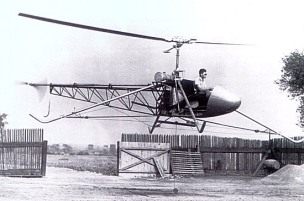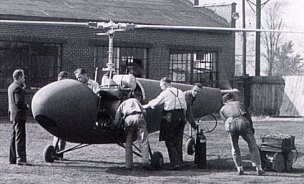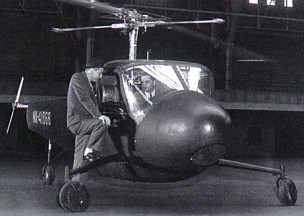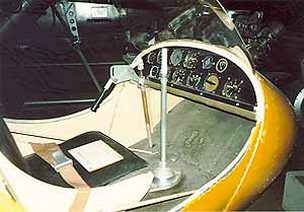| El
piloto Floyd Carlson se auto familiariza con el Modelo 30,
que se encuentra amarrado, en las instalaciones de Gardenville. |
 |
Pilot Floyd Carlson
familiarizes himself with the tethered Model 30 behind the
Gardenville facility.
|
| El
inventor Arthur Younh (centro), empujando a la Ship 1. Este
primer Modelo 30 tenía un tren de aterrizaje con
ruedas y estaba pintado de un color azul oscuro con líneas
amarillas. |
 |
Inventor Arthur
Younh (center) walks Ship 1 out of the workshop. This first Model
30 has been revised with stiffened rotor components, a wheeled
landing gear, and fabric covering painted dark blue with yellow
trim.
|
| Modelo
30, Ship 1, está siendo preparada para un vuelo de prueba. Se
le reposicionaron las patas del tren de aterrizaje, colocándolas un
poco mas atrás. |
 |
Model 30, Ship 1,
being readied for a flight in the backyard of the Gardenville
development facility. Wheels replaced by the spider landing gear
after free-flights were well along.
|
| Aeronave
reconstruida después del accidente de septiembre de 1943. Fue
redesignado como Ship 1A. Se le modificó el tren de
aterrizaje, la rueda de cola se acerco hacia el rotor principal. |
 |
Rebuilt after it
crashed in September, 1943, the first Bell helicopter was
redesignated Ship 1A. Modified landing gear had tail wheel
moved closer to the rotor hub.
|
| Modelo
30, Ship 1A, el helicóptero original fue reconstruido y
redesignado después del accidente durante una autorrotación en
1943. Floyd
Carlson está sentado en el helicóptero, a su derecha se encuentra Arthur
Young. |
 |
Model 30, Ship 1A,
the original Bell helicopter was rebuilt and redesignated after its
crash during an autorotational landing in 1943. Floyd Carlson is
seated in the helicopter, with Arthur Young to his immediate right,
leaning over.
|
| Floyd
Carlson ejecuta un vuelo estacionario en el Ship 1A, con Arthur
Young mirándolo. Este helicóptero fue rediseñado el tren de
aterrizaje y el eje del rotor de cola. |
 |
Floyd Carlson hovers
Ship 1A, while Arthur Young looks on. The helicopter was
rebuilt from the original Ship 1, with a redesigned landing
gear and modified tail rotor shaft.
|
| Modelo
30, Ship 1A, con equipo para
fumigar experimental . |
 |
Model 30, Ship 1A,
the original Bell helicopter, was fitted with this experimental
agricultural spray rig for early aerial application tests.
|
| Modelo
30, Ship 2, alistándose
para su primer vuelo en público, en el regimiento 65 de Búfalo. Floyd
Carlson, en el cockpit, hablando con Arthur
Young. |
 |
Model 30, Ship 2,
being readied for the first ever public demonstration of a Bell
Helicopter inside Buffalo's 65th Regiment Armory. Floyd Carlson, in
cockpit, is talking to Arthur Young, standing.
|
| Modelo
30 con cabina cerrada de dos plazas, volando en mayo de 1944, en el
regimiento de Búfalo. Esta aeronave voló por primera vez en
septiembre de 1943. |
 |
Featuring an
enclosed cockpit with seating for two, the second Model 30
flew in September 1943 and made this indoor demonstration at a
Buffalo armory in May 1944.
|
| Larry
Bell sentado en la cabina del Modelo
30, Ship 2, posiblemente antes de su primer vuelo, a finales de
1943 o principios de 1944. |
 |
Larry Bell sits in
the cockpit of Model 30, Ship 2, possibly before his first
flight in late 1943 or early 1944.
|
| Bell
Modelo 30, Ship 3. Se
convertiría posteriormente en la base del Modelo 47. Posado en Niagara
Falls. |
 |
Bell Model 30,
Ship 3, the unauthorized
helicopter which became the basis for the Model 47, is on the
ground at Niagara Falls.
|
| Modelo
30, Ship 3, levemente
modificado para este vuelo, transportando a siete personas en un
vuelo de demostración. El piloto es Joe
Mashman y Arthur
Young se encuentra a la derecha, mirando hacia la cámara. |
 |
Model 30, Ship 3,
slightly modified for this flight, carries seven persons in a
demonstration flight. Pilot is Joe Mashman and Arthur Young is
standing on far side, facing camera.
|

